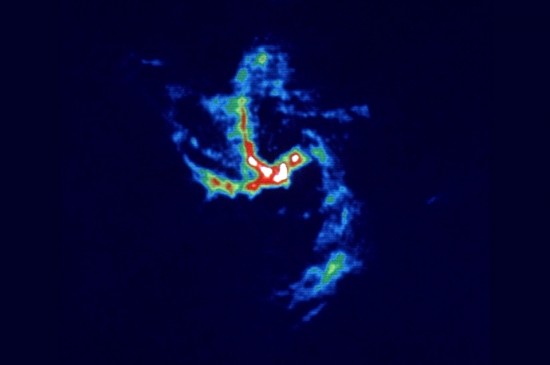Mar 31, 2014
What is lurking near the center of our galaxy?
According to a recent press release, a “magnetized neutron star”, otherwise known as a “magnetar” is spinning at an amazing speed near the Sagittarius A* (Sgr A*) region of the Milky Way. Sagittarius A* is said to be a supermassive black hole (SMBH) residing in the center of the Milky Way, approximately 26,000 light-years from Earth in the constellation Sagittarius. It is the closest SMBH, so it is used for baseline hypotheses about them. More than 95% of all galaxies are thought to harbor one or more SMBHs because the spectra from gas and dust in their centers exhibit similar characteristics.
Sgr A* said to be drawing matter from the surrounding space, where it becomes accelerated to high velocity. That speed and compression supposedly generate beams of X-rays, ultraviolet light, and radio wave emissions that are detected on Earth by telescopes like the Very Large Array (VLA).
Previous announcements from the astronomical community indicate that a cloud of gas and dust is approaching the Milky Way’s SMBH, where it is expected to be “spaghettified” by the intense gravity field’s tidal forces surrounding Sgr A*. Stefan Gillessen of the Max Planck Institute for Extraterrestrial Physics wrote: “The cloud is so stretched that the close approach is not a single event but rather a process that extends over a period of at least one year…The gas at the head of the cloud is now stretched over more than 160 billion kilometers around the closest point of the orbit to the black hole.” That stretching of matter is what is commonly referred to as spaghettification.
However, as the VLA team reports, the radio bursts that they detected are not due to the gas cloud being ripped apart by gravity, but are due to the effects of a “magnetized neutron star” spinning so fast that its radio beacon is pulsing every 3.76 seconds.
Magnetars are anomalous stars identified as X-ray pulsars (AXP) or soft gamma repeaters (SGR). They are said to be created by neutron stars with magnetic fields measuring over 10^15 Gauss. For comparison, the Earth’s magnetic field is about one-half Gauss, so these “magnetic pulsars” are surprisingly powerful sources. It must be stressed, though, that the evidence is indirect and no neutron star has ever been observed.
Some magnetars are also said to emit gamma ray bursts ascribed to “star quakes” in the ultra-hard surface of the neutron star. Because the mass per unit volume is so great, any rapid movement in the crust generates intense “magnetic reconnection,” thereby producing gamma rays. It is not necessary to reiterate the problems with magnetic reconnection, except to say that it is also one of the class of imaginary constructs created by astrophysicists.
It is a well-established fact that magnetic fields are induced by movement of electric charge. Therefore, there must be an electric current generating the intense fields in any putative magnetar. It is also indisputable that the feeder current must be part of a circuit, since persistent electric current must be part of a completed circuit.
The Electric Universe hypothesis requires no collapsed stars or rotational speeds so great that ordinary matter could never take the strain. The oscillations in magnetars (or pulsars, in general) are caused by resonant effects in electric circuits. The sudden release of stored electrical energy in a double layer is responsible for the occasional outburst of gamma rays. The outburst begins with a sudden peak of energy, and then declines gradually, like a stroke of lightning.
X-rays and gamma rays in space are not created in gravity fields. No gigantic masses compressed into tiny volumes are necessary, and such intense electromagnetic radiation is easily generated with the proper experimental models. Laboratory experiments create short wave light (like X-rays) by accelerating charged particles through an electric field.
There is no experimental evidence that matter can be compressed to “near infinite density.” Just how near to infinity must an object come? Bennet pinches in plasma filaments form plasmoids, and when the current density gets too high double layers in the circuit catastrophically release their excess energy and appear as gamma ray bursts, or X-rays, or flares of ultraviolet light.
Infrared and X-ray telescopes have confirmed the existence of a plasma-focus plasmoid at the core of the Milky Way. This high-energy electrical formation is the heart of the galactic circuit. Electrons accelerated to high speeds spiral in magnetic fields and give off X-rays. In a galactic circuit, electric power flows inward along the spiral arms, where it is concentrated and stored in the central plasmoid. When the plasmoid reaches a threshold density, it discharges, usually along the galaxy’s spin axis. This process can be replicated in a laboratory with a plasma focus device.
An understanding of electromagnetism is more than able to explain the phenomena observed in space, without recourse to supernatural black holes or magnetized pulsars, whose theoretical existence violates the laws of physics.
Stephen Smith













